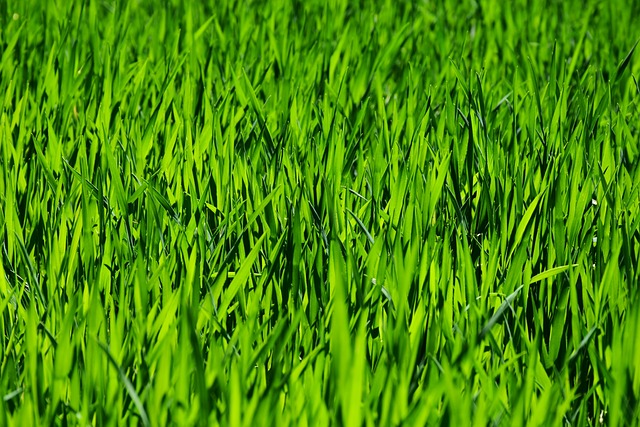Lawn care and landscaping are essential for creating a healthy, attractive garden that thrives with minimal maintenance. To achieve this, it's crucial to maintain the right mowing height for your grass type, which promotes healthy growth by allowing sunlight to reach the blades. Aeration should be performed regularly to alleviate soil compaction and improve air, water, and nutrient penetration, leading to a denser and more resilient lawn. Customized fertilization based on local climate and soil conditions provides the necessary nutrients to keep your lawn verdant year-round. Irrigation should focus on deep, infrequent watering to encourage robust root systems, especially during high-evaporation seasons. Selecting a grass variety that suits your region's climate and soil can reduce maintenance efforts. Incorporating mulch and a diverse range of plants not only conserves moisture but also supports beneficial insects and pollinators, enhancing the overall health and appearance of your outdoor space. Proper management of soil composition and pH balance is vital for plant growth, as it affects nutrient availability. Regular testing and adjustment of these factors ensure the fertility of your soil, while enriching it with compost or manure introduces beneficial microorganisms and improves its structure. By understanding and implementing these lawn care and landscaping practices, you can create a resilient, eco-friendly garden that is both visually stunning and ecologically balanced.
Embark on a journey through the lush, green expanse of your yard with expert tips on lawn care and landscaping. This comprehensive guide offers a blend of practical advice and creative strategies to nurture a vibrant outdoor space that reflects the beauty and diversity of nature. From mastering essential lawn care practices that promote a robust and healthy turf to crafting an aesthetically pleasing landscape that harmonizes with your local climate and topography, each section is designed to transform your garden into a sanctuary of serenity and pride. Discover how to integrate organic methods for soil enrichment, strategize watering techniques for optimal grass health, and select plants that thrive in your region. With these insights, you’ll elevate your gardening skills and create an outdoor haven that’s both a joy to behold and a testament to sustainable living.
Essential Lawn Care Practices for a Vibrant Yard

A thriving lawn is a cornerstone of a beautiful yard, and consistent lawn care practices are essential for achieving this lush environment. Regular mowing at the correct height for your grass type not only keeps the lawn neat but also encourages healthy growth by allowing sunlight to reach the grass blades. In addition to mowing, aeration is a vital process that helps alleviate soil compaction, allowing air, water, and nutrients to penetrate the soil and reach the roots more effectively. This enhances root growth and promotes a denser turf which can better withstand foot traffic and environmental stresses. Fertilization tailored to your local climate and soil type is another key element in maintaining a vibrant lawn. It provides the necessary nutrients for grass growth, ensuring that your yard remains green and robust throughout the seasons.
Supplementing these practices, proper irrigation is crucial for lawn health. Watering deeply but infrequently, especially during times of high evaporation like summer, helps establish deep root systems. Additionally, choosing the right grass variety for your region’s climate and soil conditions can significantly reduce the need for intensive maintenance. Finally, integrating landscaping elements such as mulch to retain moisture, and incorporating a diverse range of plants to attract beneficial insects and pollinators can further enhance the overall aesthetic and health of your lawn and garden ecosystem. With these considerations in mind, your yard will not only look its best but also serve as a resilient and environmentally friendly outdoor space for years to come.
– Understanding Soil Composition and pH Balance

Maintaining a healthy garden ecosystem begins with a thorough understanding of your soil’s composition and pH balance. Soil composition, which includes the proportions of sand, silt, and clay particles, directly affects water retention and aeration, key factors for plant health. A well-drained soil rich in organic matter supports robust root development, essential for lawn care and landscaping endeavors. Adjusting the pH balance is equally crucial; most plants thrive in slightly acidic to neutral conditions. Testing your soil’s pH can reveal if it’s too alkaline or acidic, which can lock out necessary nutrients. Amending your soil with materials like sulfur or lime can alter the pH, enhancing the bioavailability of essential elements like phosphorus and potassium that are vital for plant growth. Regular monitoring and adjustment of both composition and pH will ensure a fertile foundation for any landscaping project, promoting the lush, vibrant lawn or garden you aspire to create.
To optimize your garden’s potential through lawn care and landscaping, it’s important to implement a proactive approach to soil management. This includes incorporating compost or well-rotted manure to enrich the soil with beneficial microorganisms and humus, which improve structure and water retention. Additionally, understanding how different plants preferentially require different soil types can guide you in selecting appropriate species for your garden design. By maintaining an optimal soil pH and composition, you set the stage for a diverse range of plants to flourish, creating an aesthetically pleasing and ecologically balanced outdoor space.
Engaging in regular lawn care and landscaping practices significantly enhances both the aesthetic appeal and health of your garden. By understanding soil composition and maintaining the right pH balance, homeowners can cultivate a lush, vibrant yard that serves as a sanctuary within the bustle of daily life. A well-maintained lawn not only elevates curb appeal but also supports ecological diversity, creating an inviting space for both plants and visitors alike. As you implement these strategies, remember that consistent care and thoughtful design are key to achieving and sustaining a beautiful garden environment.
